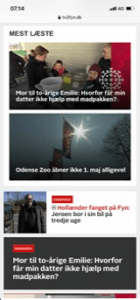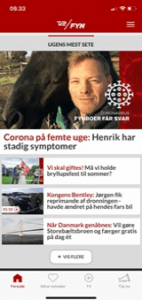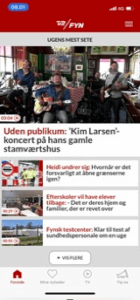Blog: The Public Helped us set the Agenda in the Middle of the Corona Hurricane
This is an exclusive peek into the Danish test center for constructive journalism at the regional tv-station TV 2 Fyn based in Funen, Denmark. Here staffers share failures and successes as they strive to make their community better through constructive journalism.
Blog: The Public Helped us set the Agenda in the Middle of the Corona Hurricane
Written by Kristina Lund Jørgensen,
Editor of Constructive Journalism, TV 2 Fyn
On March 12, the management of TV 2 Fyn made a decision to involve the Funen residents as much as possible in the coverage of corona. Concretely by using Hearken – a method for “public powered journalism” and a digital tool.
“We need to get Hearken up and running now!”
Hopefully this has moved the media house one step closer to the local citizens. At least it has already resulted in many personal stories both digitally and on TV, longer reading time on the articles on the web, and increased traffic from Google searches. And it has created stories with an extremely high degree of relevance and identification for the residents of Funen.
When Denmark closed down on March 11
It felt like a brutal lockdown in Denmark when the situation got serious fast and me and a large part of my colleagues were sent home almost immediately after the Prime Minister’s press conference on Wednesday March 11.
At the same time, potential stories from the official Denmark started pouring in from live broadcast press meetings at Christiansborg while the mailbox also flooded with more suggestions for stories. New guidelines, new rules, laws and new information about the virus, infection chains and then all the scary pictures from abroad. All media outlets suddenly faced the huge task of prioritizing the most important stories from a pile of stories that were all important.
In the months before we had planned to use Hearken in the summer as an important part of our work towards becoming a constructive media house. A method to engage audience and a tool that helps us collect questions from the citizens and then investigate and process them journalistically.
What is Hearken?
Hearken means “to listen”. Since 2016 the American consulting and tech company Hearken has been an international pioneer in user involvement in the journalistic process and has developed a method and a digital tool for cultivating public powered journalism. In 2019 the company opened a European head office in Denmark in collaboration with the publicist investment company FST Growth. The organisation now employs 20 people in the US and Europe.
We speeded up that process with an early and resolute decision to involve Funen residents directly in our work and to focus on getting close to everyday life and everyday problems in our coverage of the sudden crisis – and we wanted to focus on solutions.
Up and Running
In fact, our director, Esben Seerup, already wrote a text message on March 12 in the morning: “We need to get Hearken up and running now!”
On March 12 at 1.40 pm, we published the article “Corona outbreak on Funen: What questions do you have?”. We were up and running. At half past nine that night, we had received the first 21 questions from citizens, who wondered about different things in the new world of corona.The same day we had taken our first expert, Professor of Hygiene and Retired Doctor, Hans Jørn Kolmos, in oath.
“Questions from the public can be as good as the questions we ask ourselves at the editorial meetings.”
On March 13, he answered the first nine questions. Since then, with a few exceptions he has answered several of the health-related questions in our inbox on a daily basis.
On March 14, we had the first article on the web “The public gets answers: What about bus and ferries during corona?”.
The first of hundreds of questions journalists have investigated since March 16 where a team of Hearken reporters was put together. The first weeks the journalists were a bit skeptical. Were they supposed to answer questions in a letter box?
Along the way I think they found that the questions from the public can be as good as the questions we ask ourselves at the editorial meetings. Their questions are equally suitable for the development of critically investigated journalism when you put the time and effort into it. We didn’t do that with all questions because there were a lot. But we were trying to choose to take some of them further looking for solutions. But we can definitely do better on that point next time.
You can see our coverage here.
“The interest in the stories, readership and reading time has been overwhelming.”
Eight days after
The big question for us has been how the public would accept journalism created on the basis of their own questions. And the interest in the stories, readership and reading time has been overwhelming: After eight days the numbers for the digital platform looked like this:
- More than 150 questions asked.
- More than 20 articles published showcasing a curious audience member.
- 5 articles in the top-50 of most-read articles on the website.
- Increased traffic through curious headlines striking search engine activity. One article drew 65% of sessions through Google searches and generated 4x more views than average within a day.
And we believe that the content focused on engaging the audience not only in asking the questions but also in finding the answers or even letting them into our process when finding the answer has strengthened our relationship with them. At the same time it allowed us to cover the crisis in a more nuanced way with more input to stories than we can come up with in a traditional editorial meeting.
Qoute from a Questioner:
“I live on Funen and of course watch TV 2 Funen. They say that you can ask a question on the website. So I did. A day went by, and then I was called by a friendly journalist. She spent time on what I was thinking and feeling. A good long talk. She also asked if I would be in the local news? And I said yes. Because I’m sure there are a lot of people wondering right now. Although there is Google etc. this was something that I could not find an answer to. Here was a journalist who took care of it for me. I think TV 2 Fun could find a more real answer than if I had found it myself.”
Three weeks after
We quickly realized that it was necessary to move “The public gets answers” to the tv platform. A difficult maneuver. Partly because all the reporters at the Hearken editorial team work from home, while the team that produce for television still work from the station. Partly because the stories don’t necessarily apply to a traditional television feature.
Just have a look here on how to solve the difficult task.
But the success of the stories on the web helped to promote that work. And as we became more comfortable in all the different new roles we had been given with the new structure we got ready for tv. And it became clear after a feature that had emerged based on a user’s question and a host’s request to ask more questions many more questions will be asked.
The math looked like this after 21 days:
- Almost 400 questions from audience members.
- More than 50 audience-initiated articles and eight TV stories.
- More advanced questionnaires and three different Q&A’s with answers from both journalists, an economist and our healthcare expert.
- A +32 percent increase in average reading time on audience-initiated articles compared to the overall average in the same period. And +109 percent compared to normal reading time.





Photo: The interest in stories that arose on the basis of users’ questions also found way to our lists of the most read stories.
Now
We are heading into a summer lockdown of “The public gets answers”. Not a complete lockdown. The people of Funen can still come to us with their questions and we will still investigate some of them. We also need to gather the experiences we have gained in this first phase so that we can become even better at our public powered journalism in the future.
But we think that this way of working together with the public is exceptional. To investigate and inform about subjects the public find interesting and wonder about right now is absolutely also a part of our job in the future. We have always done this to a certain extent but with Hearken we have made it focused and consistent. We hope that it will strengthen our relation to the local community and they thus will see that we are here for them.
Constructive Journalism Tested at TV 2 Fyn.
In 2019 TV 2 Fyn gave themselves a challenge. They set out to become most constructive media as well as the largest test center for constructive journalism in Denmark. To trace the change they decided to log their experiences in a blog format offering important insights on how to become constructive.

